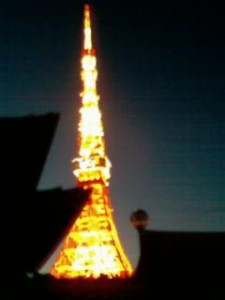I have always liked and enjoyed visiting temples and shrines throughout Japan, in particular, those that have an interesting association with Japan’s history. I recently decided to write about some of my favourite ones in Tokyo as I think they help us to appreciate that Japan has a stunning history that expands thousands of years. I start today by providing you with an overview of the one I visit on a regular basis – Zojoji.
I first became familiar with Zojoji when I worked in Tokyo with American Express in the 1980s at their office in Shiba Koen where Zojoji is located.
Zojoji was founded in 1393 and was re-located to its present location in 1598 after Ieyasu Tokugawa, the founder of the Tokugawa shogunate, moved into Edo (now known as Tokyo) in 1590 where he established his provincial government.
Zojoji soon became the Tokugawa family temple, which accounts for the splendour of its grand cathedral and its popularity with the general public. It used to also serve as the Southern Gate guardian of Ieyasu’s Edo castle, where the Imperial Palace is located today.
The Sangedatsumon, pictured above, the main entrance gate (mon) is an imposing wooden structure standing 21 metres high, is 28.7 metres wide and 17.6 metres deep. It was built in 1622 and is an architectural treasure of the original Edo period.
On your right hand side walking up to the temple you will see a big bell (Daibonsho) which was manufactured in 1673. It has a diameter of 1.76 metres, is 3.3 metres high and weighs 15 tons and is renowned as one of the Big Three Bells of the Edo Period. The bell is tolled six times twice a day – in the morning and in the evening.
Within the precincts of Zojoji are the tombs of six Tokugawa Shoguns, Imperial Princess Kazunomiya (wife of Shogun Iemochi) as well as wives and children of other Tokugawa Shoguns.
Zojoji is a Jodo shu ( Pure Land) Buddhist temple. This sect was founded in 1175 and Zojoji is its main temple as well as the central seminary for its priests and novices.
I have fond memories of visiting Zojoji in the early hours of New Year’s days (12:15am) on many occassions wrapped up for protection against the cold and warming up around urns where wooden arrows and symbols of the previous year were burnt.
I still love to walk from Hamamatsucho station to Zojoji through the outer gate while gazing at the temple and Tokyo Tower standing over it in the background – two magnificent structures from diversed eras that dominate the Shiba Koen skyline.


Ken,
That is a great picture! The juxtiposition of the two structures is great. And the history of Zojoji is simply incredible.
Thanks,
Al